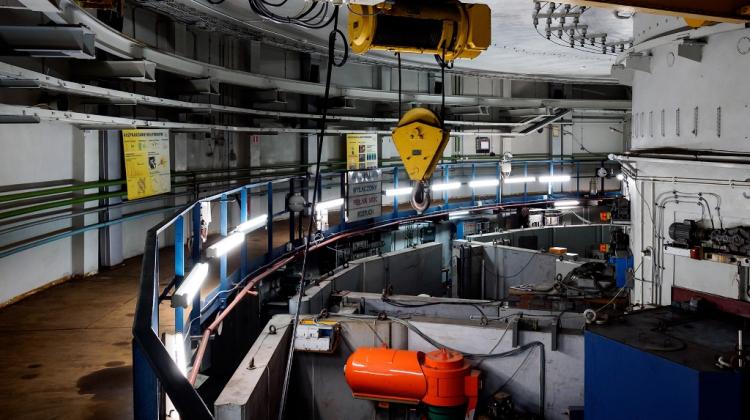Prof. Wrochna: New HTR nuclear reactors - perfect for the industry

HTR nuclear reactor, the safety of which lies in the fuel design - are devices which could benefit Polish industry. Scientists from the National Centre for Nuclear Research want to first build and test such a research reactor - told PAP Prof. Grzegorz Wrochna.
"According to Morawiecki\'s plan, now in consultation, the Polish economy will develop intensively on the basis of new technologies. One of the priority topics is the implementation of high-temperature reactors (HTR) as a source of industrial heat and power" - Prof. Grzegorz Wrochna from the National Centre for Nuclear Research said in an interview PAP.
The scientist heads the advisory team appointed by the Minister of Energy. The task of this group is to analyse and prepare the conditions for the implementation of high-temperature nuclear reactors. Prof. Wrochna is also chairman of the European Nuclear Cogeneration Industrial Initiative - NC2I.
HTR reactors (sometimes called HTGR - high-temperature gas-cooled reactors) are still waiting for their moment. So far, only a few such devices have been built in the world. "This technology is proven on a commercial level, but not widely available" - said the physicist. According to him, it is necessary to develop solutions that can be reproduced and that will work in mass production. The researcher estimates that in Poland there is a need for at least a dozen such reactors - a few hundred in Europe, and a few thousand in the world.
One of the first steps toward the HTR technology in Poland may be the construction at the National Research Centre for Nuclear Research of a small research high-temperature reactor with thermal capacity of 10 MW, producing 4 MW of electrical power. At the end of May the centre signed a letter of intent on this subject with British consortium U-Battery.
NCBJ will now seek to raise funds for the construction of the reactor from structural funds. The final financing decision should be made by the end of 2018. The reactor would be built by 2025. Prof. Wrochna noted that Polish companies and Polish scientists would be employed at the construction of the plant. In addition, Polish engineers could train on the reactor and then operate commercial reactors.
"When talking about energy, we usually think of electricity. Its production will be the task of large light water reactors planned in the Polish nuclear power program, because they offer here the best economic results. But you have to remember that a lot of energy is used for transportation, and the third part of used energy is heat" - said Prof. Wrochna. He noted that this included not only the heat for home heating, but above all the heat for industry - necessary for the operation of refineries, chemical plants, needed in the production of paper, steel and cement.
Today, fossil fuels - gas, oil, coal are used to produce heat. These materials, however - as we can expect - will become more expensive and less accessible. In addition, they cause the emission of many pollutants. "That\'s why the use of nuclear reactors is being considered. In many places in the world they are used to produce both electricity and heat - for example to supply district heating networks or desalinate sea water. In Poland, we are thinking about using them in the chemical industry" - explained Wrochna.
He said that in chemical companies heat carrier is often steam at a temperature around 450-550 deg. C. High temperature reactors offer this temperature. "In such a plant it would be enough to replace the existing boiler - for example gas boiler - with a nuclear reactor. It would not be necessary to modify the chemical installation or production facility. In addition, the reactor can be placed directly at the industrial plant. It would supply both electricity and heat" - said Prof. Wrochna.
The researcher explained that an important feature of high-temperature reactors is their safety. "Even if all safety systems cease to work, the gas - helium - escapes, and the reactor housing disappears - the fuel should cool down on its own, without releasing any radioactive materials into the environment. Safety is in the design of nuclear fuel" - the researcher told PAP.
He explained that the uranium that releases nuclear energy is enclosed in multilayer grains. The shell surrounding fuel (it consists, among other things, of pyrolytic carbon and silicon carbide) is a material resistant to high temperatures, which does not allow radioactive substances to escape.
"Such reactors are sometimes called >>walk-away reactors<< - because if failure occurred, the reactor staff could even go home - nothing would threaten neither the people or the environment" - said Wrochna. He explained that this humorous statement to some extent reflects the safety of the reactor\'s design. He noted that the advantage of such reactors - in contrast to others - is that it is not required to create safety zones or evacuation zones around them.
For these reasons, many countries are interested in the HTR technology for various applications. Prof. Wrochna mentioned that the US and Canada needed of such reactors to power remote settlements and military bases. The United Kingdom - according to the expert - considers HTR as one of the technologies for small and medium-sized reactors (i.e. SMR), in which they would like to invest, and for Indonesia HTR could be a source of power for medium-sized islands. Wrochna noted that, in turn, South Korea, Japan and the Netherlands, like Poland, focus on the chemical industry. They are even considering the development of this technology towards higher temperatures, enabling the production of hydrogen and hydrogen-based fuels. And China is now finishing the construction of two HTR-PM reactors with the capacity of 100 MW each.
According to prof. Wrochna, the implementation of this technology in Europe could facilitate and accelerate re-industrialization. "A stable, economically viable energy source, offering independence from imported fuels, is a key element for the success of such transformations. By launching an HTR technology implementation program, Poland can become the >>condensation core<<, around which a new branch of the nuclear industry in Europe will crystallize. Construction of a small HTR reactor at the National Centre for Nuclear Research is the first step in this direction" - said Prof. Wrochna.
PAP - Science and Scholarship in Poland, Ludwika Tomala
lt/ mrt/
tr. RL
Przed dodaniem komentarza prosimy o zapoznanie z Regulaminem forum serwisu Nauka w Polsce.


















